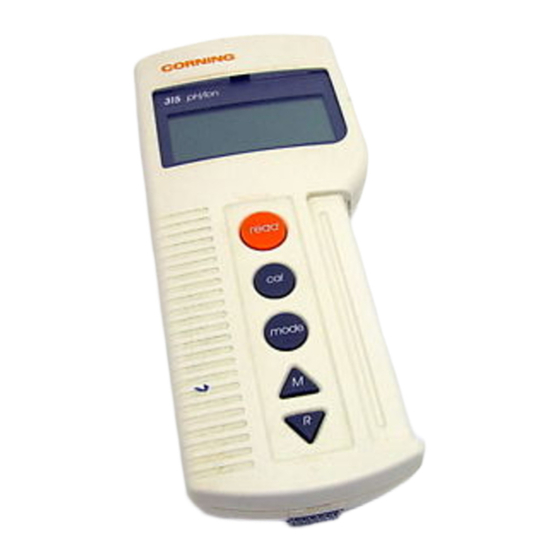CORNING 315 Manual de instalación - Página 6
Navegue en línea o descargue pdf Manual de instalación para Instrumentos de medida CORNING 315. CORNING 315 6 páginas.

Using the Memory (continued)
Recalling Memory
You can only recall stored memories if the current
measurement has endpointed.
R
Press
- the last stored memory is displayed.
Press
or
to scroll through memories.
RM 1 to RM 50 indicates which memory is being
displayed. M 0 indicates no memories stored.
Clearing the Memories
R
Press
then press
mode
Press
to clear the memories, M 0
indicates the memories have been cleared (press
read
to exit without clearing the memories).
Using Continuous
Measurement Mode
In normal mode, the 315 will auto-off 10 minutes
after the last key press, whether the unit is
measuring or has endpointed. If you select
continuous measurement mode, the 315 will not
auto-off.
To select continuous measurement mode press
M
and hold
for 2 seconds.
Using Continuous
Data Transfer Mode
In continuous data transfer mode readings are
sent to the data output approximately every
second. If the measurement endpoints (manually,
or using auto endpoint) data transfer stops. If you
recall memories all stored readings are output,
(from the first to the last stored).
To select continuous data transfer mode press
R
and hold
for 2 seconds.
If you want to use this mode to monitor
continually, you also need to select
continuous measurement mode.
To maintain continuity of sample readings
calibration data is not output in continuous
data transfer mode.
Interfacing
Serial Output
The 315 can interface with computers, printers
and other RS232 compatible devices. The RS232
Interface Kit (Cat. 470445) converts data from the
6 pin socket to RS232 format.
Type of communication - uni directional, baud
rate 1200, data format - 1 start bit : 8 data bits :
1 stop bit : no parity
Data is sent to the output socket at measure-
ment endpoint (manual or automatic),
calibration recall and memory recall.
or
until M C is displayed.
Interfacing (continued)
To use the output to monitor continually, you
need to select continuous measurement
mode and continuous data transfer mode.
Recorder Output
An output is available, via the Recorder Cable
(Cat. 470446), for all modes. The polarity of the
output is the same as the polarity of the input
signal.
Approximate Recorder Outputs
pH - Output follows display and provides
approximately 60 mV output/pH unit. This value
varies with changes in electrode slope.
mV - Output follows display, i.e. output varies
from –1999.9 to 1999.9 mV.
Concentration - Output depends on valency and
charge of ionic species being measured, and is
typically approximately ± 60 or ± 30 mV/decade.
Recorder output is not available for temperature.
315 Data Socket
protective ground (0V)
recorder output
CAUTION: The 315 does not meet IP67 when the
waterproof output socket seal has been removed.
Operating Hints
Remove the wetting cap from the end of the
electrode and the rubber cap from the fill hole (if
fitted) before using the electrode.
Calibrate using buffers or standards with values
that bracket that of the sample. With a new pH
electrode, or after maintenance, we recommend
you use a buffer close to pH 7 for the first
calibration point.
For greatest accuracy, buffers or standards and
samples should be at the same temperature.
Do not use solutions after the expiration date.
When transferring the electrode from one
solution to another, rinse it with distilled water
and blot dry with tissue paper - do not wipe the
electrode as this may cause polarization and
slow response.
When you select the calibration buffers/
standards (Program Menu), set the buffer or
standard you will use most frequently for 1-point
calibrations as cal 1, the one you will use most
frequently for the second calibration point as cal
2, and so on.
Calibrate in concentration mode using the units
you want for sample measurement. Changing
the units does not change the reading; e.g. the
315 does not convert from ppm to mmol.
